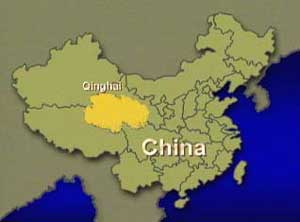 This is a map of Qinghai Province. Qinghai province is in the north west of China where the Yangtze and Yellow rivers originate. Qinghai province occupies an area of over 700,000 square kilometers and has a population of over 5 million people. It is also noted for the Qinghai lake, which is the largest inland lake in China. The Riyueshan Mt. Range divides the province in two parts. To the east lie the capital Xining and the agricultural region, and to the west is the pastoral region, where the majority of the province's livestock is raised. This is a map of Qinghai Province. Qinghai province is in the north west of China where the Yangtze and Yellow rivers originate. Qinghai province occupies an area of over 700,000 square kilometers and has a population of over 5 million people. It is also noted for the Qinghai lake, which is the largest inland lake in China. The Riyueshan Mt. Range divides the province in two parts. To the east lie the capital Xining and the agricultural region, and to the west is the pastoral region, where the majority of the province's livestock is raised.
Qinghai is situated in the northeast of the Qingzang Plateau with an average altitude of over 3000 meters above sea level. Two great rivers in China, the Yangtze River and the Yellow River, originate in this province which is also one of the four major pastoral areas in China. Mountain ranges that stretch for more than 1000 km, such as Qilian, Aljin, Kunlun and Tanggula, form the skeleton of Qinghai's land formation. High altitude, cold climate, and oxygen deficiency have rendered Qinghai her unique and vigorous natural ecosystem. But at the same time, it is also an environment of great vulnerability.
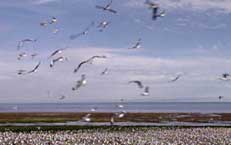 Situated high up on the Qingzang Plateau, Qinghai lake occupies an area of more than 4500 square kilometers. At 3200 m above sea level, its waters are extremely cold and salty. They are, however, teeming with fish and populated by nesting birds. Situated high up on the Qingzang Plateau, Qinghai lake occupies an area of more than 4500 square kilometers. At 3200 m above sea level, its waters are extremely cold and salty. They are, however, teeming with fish and populated by nesting birds.
Riyueshan Mountain is the watershed of the Qingzang Plateau and the inland Loess Plateau. It also severs the province's agricultural area from the pastoral area, where the land is carpeted by endless grasses without a single tree. The Qinghaihu Lake is located 60 to 70 kms from Riyeshan Mountain. It is the largest saltwater lake in China, covering an area of more than 4,400 square kilometers. Due to climate and environment changes, as well as inconsistent rainfall, the level of Qinghaihu Lake is dropping at a rate of 10cm per year. The former "Bird Island" within the lake, which used to be inhabited by many birds, now has become a peninsular. As a part of the Qingzang Plateau, the Qinghaihu Lake has always been a shrine for mountaineers and explorers from all over the world.
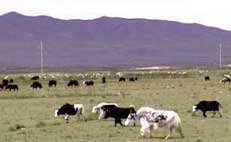 Qinghai Province is rich in cultural history. It is the source of the Chinese Kunlun legend which was passed around the country and finally blended with mainstream of Chinese culture. The province is, however, less famous for its economic success, for it has always been an area in China that has remained economically undeveloped. When people think of Qinghai, they imagine a vast land which is rich in natural resources, but one which is sparsely populated and progressing slowly. Qinghai Province is rich in cultural history. It is the source of the Chinese Kunlun legend which was passed around the country and finally blended with mainstream of Chinese culture. The province is, however, less famous for its economic success, for it has always been an area in China that has remained economically undeveloped. When people think of Qinghai, they imagine a vast land which is rich in natural resources, but one which is sparsely populated and progressing slowly.
Qinghai is rich in resources. The Qaidam Basin in Qinghai boasts its plentiful resources in its salt lake, such as petroleum, natural gas as well as metal and nonmetals such as asbestos, lead and zinc. 123 different minerals have been discovered in Qinghai and the exact amount of their reserves is known for 97 of these minerals. Qinghai is ranked among the top 10 provinces that hold the largest amount of mineral reserves for 51 of these resources in terms of China's total reserves. As the origin of China's two big rivers, Qinghai province also has ample water resources.
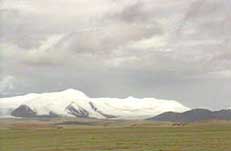 Out of all the northwestern provinces, Qinghai has the highest number of hydro-electric power plants. This particular one is the Li Jia Xia plant and it is situated along the upper reaches of the Yellow River. Out of all the northwestern provinces, Qinghai has the highest number of hydro-electric power plants. This particular one is the Li Jia Xia plant and it is situated along the upper reaches of the Yellow River.
The Yellow River flows a distance of 276 km which includes 865 meters of vertical flow within Qinghai's territory. It is capable of running 6 large-sized and 7 medium-sized hydroelectric stations. The already completed Longyangxia hydro-electric station and the Lijiaxia station, still under construction, have set new records for the largest volume of generating units from a single hydroelectric plant. The construction of terrace power stations near the upper reaches of the Yellow River will also increase Qinghai's hydropower production. 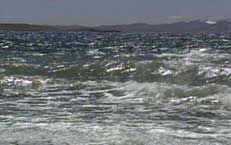 Qinghai is one of the least populated provinces in China. People of Han, Tibetan, Hui, Mongolian, Sala, and Tu ethnicities all inhabit the region. Qinghai is a cultural melting pot, not only for Han Chinese and Tibetans, but also for many other ethnic groups. Meanwhile, Qinghai is also a holy land for Tibetan Buddhism. The religious art and folk art that stems from Tibetan Buddhism has become an important part of Chinese culture and it has added brilliance to the Qingzang Plateau. Why has Qinghai been such an economically undeveloped province in spite of her special advantages over eastern China? Since 1949, when the People's Republic of China was founded, Qinghai has achieved remarkable progress in agriculture, stock-raising and especially, industry. The whole range of industries such as smelteries, textiles and machinery companies have been established. Situated inland, however, Qinghai is snagged by problems of high altitude, oxygen deficiency, and poor transportation facilities. Moreover, the long-term dependence on aid from the central government has left her economically weak. The central government's current financial help merely keeps Qinghai's governmental operations afloat. The development of resources requires large investment and a long period of capital recycling. Not only capital, but also high-tech products and machinery are required to change present primary production. Besides, long-term dependence on the central government has formed a very traditional ideology of a rural economy in the people's minds. The concept of a market and a commodity economy is stronger in the minds of people in the coastal areas. Through the drive to develop the west, the Chinese government offers a rare opportunity for Qinghai Province. Qinghai is one of the least populated provinces in China. People of Han, Tibetan, Hui, Mongolian, Sala, and Tu ethnicities all inhabit the region. Qinghai is a cultural melting pot, not only for Han Chinese and Tibetans, but also for many other ethnic groups. Meanwhile, Qinghai is also a holy land for Tibetan Buddhism. The religious art and folk art that stems from Tibetan Buddhism has become an important part of Chinese culture and it has added brilliance to the Qingzang Plateau. Why has Qinghai been such an economically undeveloped province in spite of her special advantages over eastern China? Since 1949, when the People's Republic of China was founded, Qinghai has achieved remarkable progress in agriculture, stock-raising and especially, industry. The whole range of industries such as smelteries, textiles and machinery companies have been established. Situated inland, however, Qinghai is snagged by problems of high altitude, oxygen deficiency, and poor transportation facilities. Moreover, the long-term dependence on aid from the central government has left her economically weak. The central government's current financial help merely keeps Qinghai's governmental operations afloat. The development of resources requires large investment and a long period of capital recycling. Not only capital, but also high-tech products and machinery are required to change present primary production. Besides, long-term dependence on the central government has formed a very traditional ideology of a rural economy in the people's minds. The concept of a market and a commodity economy is stronger in the minds of people in the coastal areas. Through the drive to develop the west, the Chinese government offers a rare opportunity for Qinghai Province.
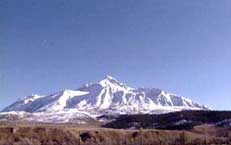 At present the people in Qinghai are centering all their efforts on the economic growth of the region. Xining, which is fascinating mix of both the old and the new, is inhabited by 36% of the province's total population. This 36% has contributed 35% of the province's GDP, over 50% of industrial products and over 50% of total tax revenue. This indicates that in recent years, Qinghai has been speeding up her pace of development. At present the people in Qinghai are centering all their efforts on the economic growth of the region. Xining, which is fascinating mix of both the old and the new, is inhabited by 36% of the province's total population. This 36% has contributed 35% of the province's GDP, over 50% of industrial products and over 50% of total tax revenue. This indicates that in recent years, Qinghai has been speeding up her pace of development.
The development of the west makes people in Qinghai realize that their own efforts and creativity are the only way to relieve their poverty. We have seen on-going construction all over Xining. Qinghai is attracting investment from eastern China and abroad through the improvement of facilities of her capital city. There is a Chinese saying that roads are the precursor to fortune. In the capital city of Xining, road construction can be seen everywhere. People's minds are occupied with the region's economic progress.
Interview: A student
My mother used to tell me to study hard and go to college in order to make a living in the world. I hadn't wanted to stay in Xining for the city seemed so poor. But the development of the west has brought big changes to the economy here. A lot of companies have popped up. I have applied for a course in computer engineering at a vocational high school this year. I have made up my mind to work hard and seek my future career here. I don't want t move away any more.
 Interview: Senior citizen Interview: Senior citizen
I have been living here for 40 years. This place used to be just a big hollow place full of smelly dirty water. The environment was rather disgusting. But thanks to the attention of the provincial, municipal, and central government, especially during the last two years, there have been many changes and it has now changed into a place for cultural recreation. Great changes have taken place particularly in the last two years. I believe we will see an even more beautiful Xining.
In order to spur economic growth through the development of the west, Qinghai has accelerated the pace of infrastructure construction. The capital city, Xining, and the rising industrial city, Geermu, have taken on a new look, offering a better environment in terms of working and living conditions for investors from outside.
|









